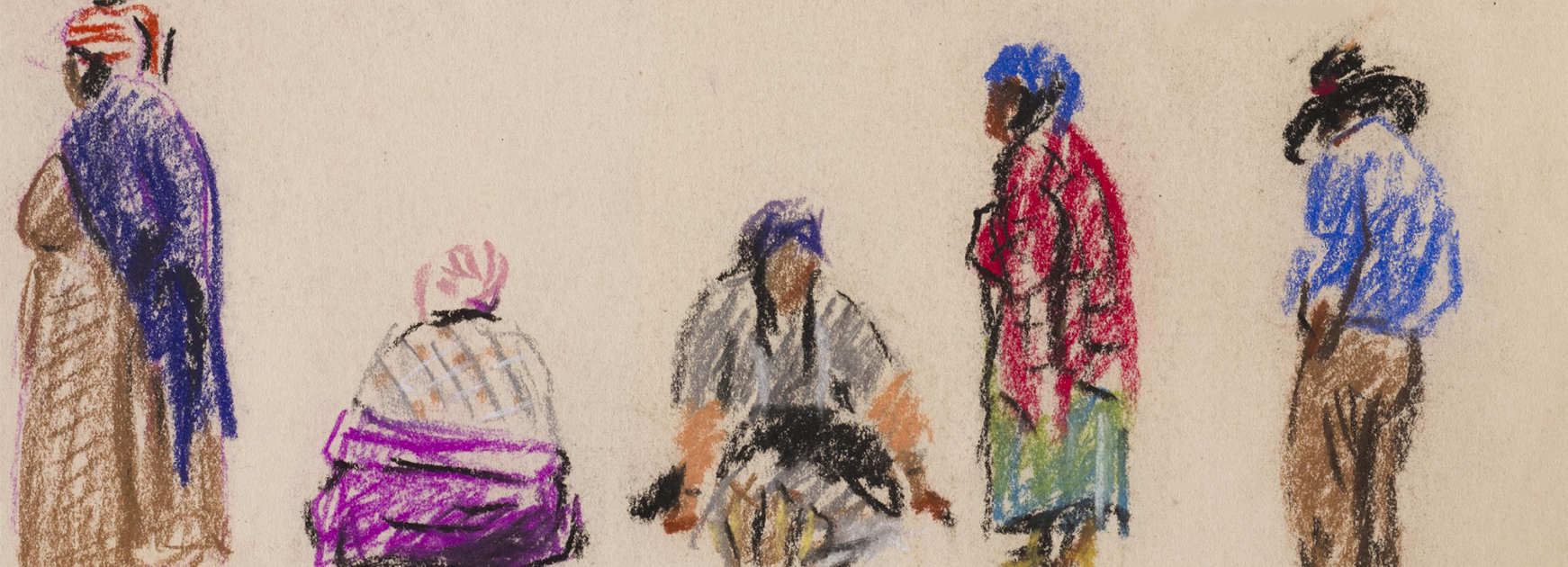Clyfford Still: The Colville Reservation and Beyond, 1934-1939
May 8–September 13, 2015
Denver, CO—The world’s most intact public collection of a major American artist offers another in-depth inquiry into creative development this summer. Clyfford Still: The Colville Reservation and Beyond, 1934-1939 presents an early chapter in Clyfford Still’s groundbreaking path towards Abstract Expressionism. The exhibition and its catalogue of new scholarship explore how Still’s time with indigenous people of northeastern Washington State contributed to a tragic sensibility realized in his later work.
Approximately thirty original works on paper and eight oil-on-canvas compositions by Clyfford Still comprise the exhibition, along with sketch-oriented materials, related photographs, and examples of the artist’s self-described “interpretive studies” executed in the middle and late1930s in Pullman, Washington. Subject matter ranges from carefully observed portraits of tribal members to dramatic, semi-abstract paintings of human figures. The work comes from Still’s years as a faculty member at Washington State College (WSC), when he co-founded a summer artists’ retreat on Washington’s Colville Indian Reservation. Dozens of the works in this exhibition are being shown publicly for the first time.
In the shadow of a massive project to build Grand Coulee Dam, the largest electric power-producing facility in the United States, two artists—Clyfford Still and his colleague at Washington State College in Pullman, Worth Griffin–established State College Summer Art Colony in 1937 in Nespelem, a small village on the vast Colville Reservation of northeastern Washington State. The depressed
U.S. economy that ultimately brought about the dam construction was also responsible for exacerbating poverty on the reservation. By 1938 the progress of the dam stopped the salmon migration essential to tribal cultural traditions. When Grand Coulee was completed, entire communities on the reservation were flooded.
The culture of Native Americans is a well-documented source of inspiration for several of Still’s future abstract expressionist colleagues, including Jackson Pollock and Barnett Newman. Among this group, however, only Still had prolonged contact with native peoples. His initial responses were conflicted: the Colville reservation was inhabited, he wrote, by “beautiful, tragic people” attired in brilliantly colored shawls, shirts and ceremonial regalia, living in “wretchedly impoverished” conditions. Still’s experiences at Nespelem and with the Colville people resonate in chromatic structures he developed in his later works, but his observations of the peoples’ intimate rapport with their natural environment may have made an even more profound impression. The visual products Still created on the reservation and in his Pullman studio in the 1930s appear to be the work of two different minds, but both bodies of work belong to the process of intensifying and clarifying a tragic vision that would soon inspire some of the most original paintings in the history of American art.
Clyfford Still: The Colville Reservation and Beyond, 1934-1939 is curated by Patricia Failing, Professor Emerita, Division of Art History, University of Washington, Seattle. A catalogue accompanies the exhibition, available for purchase at the Museum and shop.clyffordstillmuseum.org. A brief video feature on the exhibition’s content is also available to guests of the Museum.
ABOUT THE CLYFFORD STILL MUSEUM
Home to the world’s most intact public collection of a major American artist, the Clyfford Still Museum opened in November of 2011 to promote public and scholarly understanding of the life and work of Clyfford Still (1904–80). Considered one of the most important painters of the twentieth century, Still was among the first generation of Abstract Expressionist artists who developed a new, powerful approach to painting in the years following World War II. In addition to approximately 9,000 square feet of exhibition space devoted solely to the artist’s work, the Museum also houses the Clyfford Still Museum Archives and the Clyfford Still Museum Research Center. The Los Angeles Times calls the Museum “a marvelous model for what a single-artist museum can be;” Smithsonian Magazine describes the Museum as “among the best art museum experiences anywhere.” The Museum was designed by Allied Works Architecture, which received the 2013 Design Award, 2012 Honor Award, and 2012 Craftsmanship Award from the American Institute of Architects for the project.
